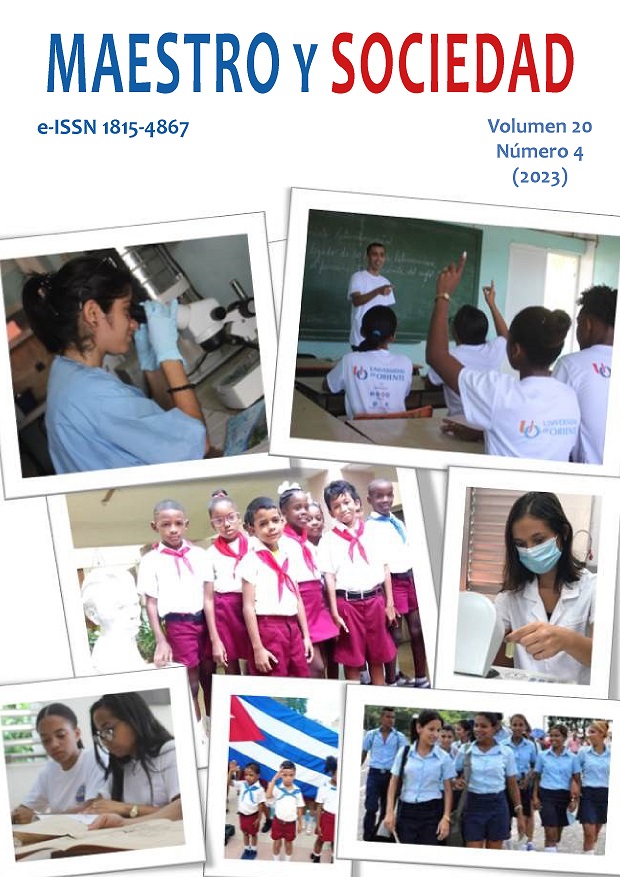Neurodidactic methodological strategy for teaching-learning in the area of natural sciences in the fourth year of basic education
Keywords:
Neurodidactics, Methodological strategy, Natural Sciences, Teaching-learning, Basic education, Diagnosis, Evaluation by expert criteria, Educational neuroscienceAbstract
Neurodidactics has emerged as an interdisciplinary field of study that combines neuroscience and pedagogy to improve the teaching-learning process. The main objective of this study is to design, implement and evaluate a neurodidactic methodological strategy in the area of Natural Sciences for fourth year elementary school students, specifically at the Abraham Barzallo School. The research was conducted using a mixed approach combining qualitative and quantitative elements. The methodology employed was based on a qualitative approach that embraced the phenomenological paradigm and the hermeneutic method. An exhaustive diagnosis was carried out that included a review of pedagogical practices, as well as surveys applied to both students and teachers during two months. Based on the results of the diagnosis, a neurodidactic methodological strategy adapted to the needs of the educational community of the Abraham Barzallo School was designed. This strategy incorporated principles of educational neuroscience, such as attention activation, connection with previous experiences and memory reinforcement. The results of this study indicate that the neurodidactic methodological strategy designed for Natural Sciences in the fourth year of basic education was positively evaluated by the experts. The strategy was found to be clear in its objectives, adequate in the proposed activities, coherent with the principles of educational neuroscience and motivating for the students. In addition, the experts highlighted its adaptability and its alignment with the resources available in the school.
References
Barbosa, E. Y. (2021). A neurodidactic model for teaching elementary EFL students in a college context. English Language Teaching, 14(3), 42-58. https://doi.org/10.5539/elt.v14n3p42
Barros, C. D., & Fernández, A. H. (2022). Neuroscience, neuroeducation, neurodidactics and technology. Texto Livre: Linguagem e Tecnologia, 15(e41235, 2022). https://doi.org/10.35699/1983-3652.2022.41235
Bowers, J. S. (2016). The practical and principled problems with educational neuroscience. Psychological Review, 123(5), 600–612. https://doi.org/10.1037/rev0000025
Carrillo Cusme, Z. L., & Zambrano Montes, L. C. (2021). Estrategias neurodidácticas aplicadas por los docentes en la escuela Ángel Arteaga de Santa Ana. Revista San Gregorio, 1(46), 144-157.
Cedeño, G. C. B., & Bailón, J. B. (2021). Estrategias neurodidácticas en el proceso enseñanza-aprendizaje de educación básica. ReHuSo: Revista de Ciencias Humanísticas y Sociales, 6(1), 72-81.
Coronel, C. G. V., & Asitimbay, A. C. C. (2021). La neurociencia educativa: Una propuesta ante la necesidad de una educación de calidad en Ecuador. Dominio de las Ciencias, 7(1), 45.
Gijón Puerta, J., Khaled Gijón, M., Matas Lara, A., & García Sempere, P. (2022). El mapa conceptual y el software CmapTools como herramientas neurodidácticas para la mejora del aprendizaje. Texto Livre/Texto Livre: Linguagem e Tecnologia, 15.
Juvova, A., Chudy, S., Neumeister, P., Plischke, J., & Kvintova, J. (2015). Reflection of constructivist theories in current educational practice. Universal Journal of Educational Research, 3(5), 345-349.
Lena-Acebo, F. J. (2018). Aplicación del método Delphi en el diseño de una investigación cuantitativa sobre el fenómeno FABLAB. EMPIRIA. Revista de Metodología de las Ciencias Sociales, (40), 129-166.
Machuca, S. A., Morejon, E. R., Munzon, G. M., Naspud, C. U., Tapia, J. J., & Tello, E. D. R. (2023). La neurociencia en el proceso educativo intercultural del Bachillerato en Ecuador. Revista ESPACIOS, 44(04). https://doi.org/10.48082/espacios-a23v44n04p07
Malsagova, M. K. (2020). Directions and trends in the development of neurodidactics. American Scientific Journal, (43-2), 9-11. https://doi.org/10.31618/asj.2707-9864.2020.2.43.57
Meneses Granados, N. (2019). Neuroeducación. Sólo se puede aprender aquello que se ama, de Francisco Mora Teruel. Perfiles educativos, 41(165), 210-216.
Morales, V. M. (2018). Capítulo VI: La neurodidáctica, una revisión conceptual. Innovación psicológica, 154-169.
Pérez, E., Del Rey, M., y González, D. (2019). La neurociencia en la formación inicial de docentes. Revista Pedagógica de la Universidad de Cienfuegos, 15(67), 241-249.
Ramos, M. E. A., & Arnaiz, N. V. Q. (2022). Estrategia neuroeducativa para optimizar el aprendizaje matemático de los estudiantes de educación básica elemental. Mikarimin. Revista Científica Multidisciplinaria, 8(3), 85-104.
Rodríguez, J. R., & Alvarez, M. R. (2020). Calcular la fiabilidad de un cuestionario o escala mediante el SPSS: el coeficiente alfa de Cronbach. REIRE: revista d'innovació i recerca en educació, 13(2), 8.
Terigi, F. (2016). Sobre aprendizaje escolar y neurociencias. Propuesta educativa, (46), 50- 64. http://www.scielo.org.ar/scielo.php?script=sci_arttext&pid=S1995- 77852016000200006&lng=es&tlng=es.
Uyaguari, J. P. E., Morocho, S. M. C., & Sánchez, E. E. L. (2023). El Cerebro en Acción: Integración Neurodidáctica de Analogías, Gamificación y Visual Thinking en el Proceso Educativo: The Brain in Action: Neurodidactic Integration of Analogies, Gamification and Visual Thinking in the Educational Process. LATAM Revista Latinoamericana de Ciencias Sociales y Humanidades, 4(3), 400-409.
Vantroba, E. L., Rodrigues, M. A. C., Lopes, G. C. D., de Sousa, N. E., da Silveira, F. M., Barbosa, F. C., & Oh, H. S. (2023). Neurociência e educação: propostas e contribuições para a aprendizagem contemporânea. Revista de Gestão e Secretariado (Management and Administrative Professional Review), 14(3), 4358-4367.
Published
How to Cite
Issue
Section
License
Copyright (c) 2023 Mercedes Marilu Rodríguez Jiménez, Dalila Isabel Merchán Cornejo, Giselle Aurelia Rodriguez Caballero

This work is licensed under a Creative Commons Attribution-NonCommercial-NoDerivatives 4.0 International License.
This journal provides immediate open access to its content, based on the principle that offering the public free access to research helps a greater global exchange of knowledge. Each author is responsible for the content of each of their articles.



























 Universidad de Oriente
Universidad de Oriente 